Hot Composting Comparison: Best vs. Easy
Hot composting comparison reveals a fascinating dichotomy in the world of organic waste management. On one hand, you have the “best” method, often characterized by precise control over variables, leading to rapid decomposition and a nutrient-rich finished product. On the other, you have the “easy” approach, embracing a more hands-off philosophy, forgiving of minor imperfections, and ultimately delivering compost with a bit more patience. Understanding the nuances between these two philosophies can significantly impact your composting success, whether you’re a seasoned gardener or a curious beginner.
The “Best” Hot Composting: Precision and Speed

The pursuit of “best” in hot composting often stems from a desire for efficiency and optimal results. This method emphasizes the critical conditions required for thermophilic microorganisms to thrive and rapidly break down organic matter. The core principles revolve around achieving and maintaining the correct carbon-to-nitrogen (C:N) ratio, moisture content, and aeration.
Achieving the Ideal C:N Ratio: The “best” practitioner meticulously balances “greens” (nitrogen-rich materials like grass clippings, fresh plant trimmings, and kitchen scraps) with “browns” (carbon-rich materials like dried leaves, straw, shredded cardboard, and sawdust). A target ratio of around 25-30 parts carbon to 1 part nitrogen by weight is generally considered ideal. This requires careful measurement and selection of materials. For example, a compost pile dominated by grass clippings (high nitrogen) without enough dried leaves (high carbon) will likely become a slimy, smelly mess. Conversely, an excess of browns will lead to slow decomposition.
Optimal Moisture: The “best” method also involves precisely monitoring moisture levels. The compost should feel like a wrung-out sponge – damp but not waterlogged. Too little moisture will halt microbial activity, while too much can lead to anaerobic conditions, which breed unpleasant odors and slow down decomposition. Regular checks and adjustments, either by adding water or dry materials, are paramount.
Effective Aeration: Proper airflow is another cornerstone of the “best” approach. Microorganisms involved in hot composting are aerobic, meaning they require oxygen. This is typically achieved through regular turning of the compost pile. Frequency can vary, but some advocating for the “best” method might turn their piles every few days, ensuring good oxygen penetration and mixing of materials. This also helps distribute heat and moisture evenly.
The Payoff: The rewards of this meticulous approach are substantial. Hot compost piles can reach temperatures of 130-160°F (54-71°C) within days. This high heat effectively kills weed seeds and pathogens, resulting in a cleaner, more sanitized compost. The accelerated decomposition process means you can often produce finished compost in as little as 4-6 weeks, ready to enrich your garden soil.
The “Easy” Hot Composting: Patience and Forgiveness

In contrast, the “easy” hot composting approach prioritizes simplicity and a more relaxed attitude towards the composting process. It acknowledges that achieving perfect conditions every time is not always practical or necessary for many home composters. This method is more about harnessing the power of nature with minimal intervention, understanding that decomposition will happen, albeit at a slower pace.
Embracing the Mix: The “easy” composter is less concerned with precise C:N ratios. While they still aim for a balance of greens and browns, they are more likely to add materials as they become available, trusting that the pile will eventually find its equilibrium. They might throw in kitchen scraps and yard waste without extensive pre-sorting or calculation, accepting that some materials might take longer to break down.
Moisture Management Lite: Moisture is still important, but the “easy” method often relies on natural rainfall and the inherent moisture of added materials. They might give the pile a quick dousing with a hose if it looks exceptionally dry, or add some dry leaves if it appears too soggy. The emphasis is on preventing extreme dryness, rather than maintaining a precise level.
Occasional Turning (or Not): Turning is viewed as beneficial but not strictly essential. An “easy” composter might turn their pile every few weeks, or even less frequently, relying on natural processes like wind and gravity to introduce some air. Some even opt for passive composting, where the pile is simply left to decompose over a longer period with minimal disturbance.
The Outcome: While the “easy” method might not reach super-heated temperatures, it still effectively breaks down organic matter. The decomposition process will take longer, potentially months rather than weeks. The finished compost may not be as sterile as that produced by the “best” method, and there’s a slightly higher chance of encountering weed seeds or slower-decomposing material. However, the resulting compost is still incredibly valuable for improving soil structure, fertility, and water retention – the ultimate goals of composting.
Making Your Choice: Best vs. Easy Hot Composting

The decision between the “best” and “easy” hot composting methods largely depends on your individual circumstances, goals, and available time.
Choose the “Best” if:
You want the fastest possible compost.
You are serious about eliminating weed seeds and pathogens.
You have the time to regularly monitor and turn your pile.
You enjoy the precision and scientific aspects of gardening.
You have a consistent supply of diverse organic materials.
Choose the “Easy” if:
You are a busy individual with limited time for composting.
You are new to composting and want a forgiving approach.
You are not overly concerned about the exact timeline for finished compost.
You have a more relaxed approach to gardening and waste management.
You are content with compost that improves soil health even if it takes longer to produce.
Ultimately, both approaches to hot composting comparison lead to a beneficial outcome: nutrient-rich compost for your garden. The “best” offers speed and sterilization through diligent management, while the “easy” provides a more relaxed and accessible path to the same enriching end product. The most important step, however, is to simply begin composting. By diverting organic waste from landfills and returning valuable nutrients to your soil, you are making a positive impact, regardless of which method you choose.
.lwrp.link-whisper-related-posts{
margin-top: 40px;
margin-bottom: 30px;
}
.lwrp .lwrp-title{
}.lwrp .lwrp-description{
}
.lwrp .lwrp-list-container{
}
.lwrp .lwrp-list-multi-container{
display: flex;
}
.lwrp .lwrp-list-double{
width: 48%;
}
.lwrp .lwrp-list-triple{
width: 32%;
}
.lwrp .lwrp-list-row-container{
display: flex;
justify-content: space-between;
}
.lwrp .lwrp-list-row-container .lwrp-list-item{
width: calc(25% – 20px);
}
.lwrp .lwrp-list-item:not(.lwrp-no-posts-message-item){
max-width: 150px;
}
.lwrp .lwrp-list-item img{
max-width: 100%;
height: auto;
object-fit: cover;
aspect-ratio: 1 / 1;
}
.lwrp .lwrp-list-item.lwrp-empty-list-item{
background: initial !important;
}
.lwrp .lwrp-list-item .lwrp-list-link .lwrp-list-link-title-text,
.lwrp .lwrp-list-item .lwrp-list-no-posts-message{
}@media screen and (max-width: 480px) {
.lwrp.link-whisper-related-posts{
}
.lwrp .lwrp-title{
}.lwrp .lwrp-description{
}
.lwrp .lwrp-list-multi-container{
flex-direction: column;
}
.lwrp .lwrp-list-multi-container ul.lwrp-list{
margin-top: 0px;
margin-bottom: 0px;
padding-top: 0px;
padding-bottom: 0px;
}
.lwrp .lwrp-list-double,
.lwrp .lwrp-list-triple{
width: 100%;
}
.lwrp .lwrp-list-row-container{
justify-content: initial;
flex-direction: column;
}
.lwrp .lwrp-list-row-container .lwrp-list-item{
width: 100%;
}
.lwrp .lwrp-list-item:not(.lwrp-no-posts-message-item){
max-width: initial;
}
.lwrp .lwrp-list-item .lwrp-list-link .lwrp-list-link-title-text,
.lwrp .lwrp-list-item .lwrp-list-no-posts-message{
};
}

I am passionate about home engineering. I specialize in designing, installing, and maintaining heating, ventilation, and air conditioning systems. My goal is to help people stay comfortable in their homes all year long.

